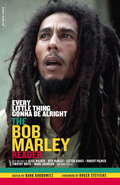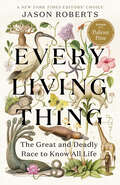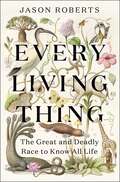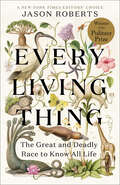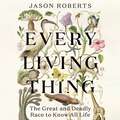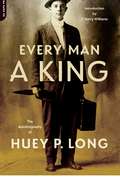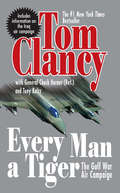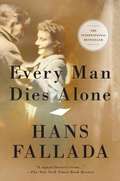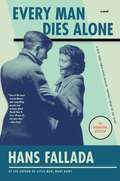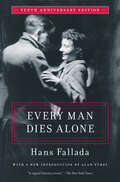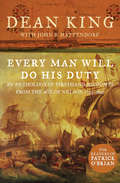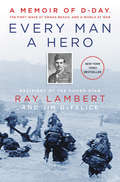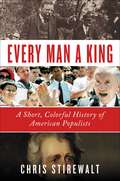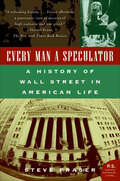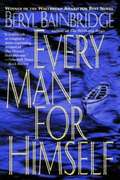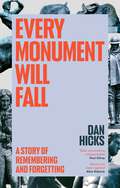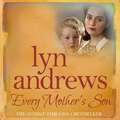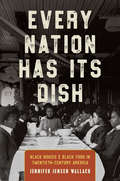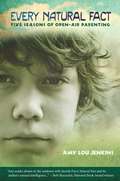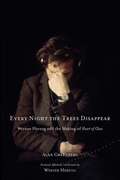- Table View
- List View
Every Little Thing Gonna Be Alright: The Bob Marley Reader
by Hank BordowitzThroughout Africa, the Caribbean, Europe, and America, Bob Marley represents far more than just the musician who translated spiritual and political beliefs into hypnotic, hard-hitting songs such as "Get Up, Stand Up," "No Woman, No Cry," and "Jammin'. " Marley was born in rural Jamaica and reared in the mean streets of Kingston's Trenchtown; his ascent to worldwide acclaim, first with The Wailers--Peter Tosh and Bunny Livingstone--and later as a solo artist, is a riveting story of the spiritual awakening of a uniquely talented individual. Now, for the first time, a symphony of voices has joined together to offer perspective on one of this century's most compelling figures. Dealing with Bob Marley as a man and myth, from his "rude boy" teens to international fame and his tragic death at the age of thirty-six, Every Little Thing Gonna Be Alright then explores the larger picture, examining Marley as the spokesman for Jamaica's homegrown religion of Rastafarianism, as a flash point for the pressure cooker of Jamaican politics, and his unique status as the first pop musical superstar of the so-called "Third World. "
Every Living Thing: The Great and Deadly Race to Know All Life
by Jason RobertsFrom the bestselling author of A Sense of the World comes this dramatic, globe-spanning and meticulously-researched story of two scientific rivals and their race to survey all life on Earth.In the 18th century, two men dedicated their lives to the same daunting task: identifying and describing all life on Earth. Their approaches could not have been more different. Carl Linnaeus, a pious Swedish doctor with a huckster's flair, believed that life belonged in tidy, static categories. Georges-Louis de Buffon, an aristocratic polymath and keeper of France's royal garden, viewed life as a dynamic swirl of complexities. Both began believing their work to be difficult, but not impossible—how could the planet possibly hold more than a few thousand species? Stunned by life's diversity, both fell far short of their goal. But in the process they articulated starkly divergent views on nature, on humanity's role in shaping the fate of our planet and on humanity itself. The rivalry between these two unique, driven individuals created reverberations that still echo today. Linnaeus, with the help of acolyte explorers he called "apostles" (only half of whom returned alive), gave the world such concepts as mammal, primate and homo sapiens—but he also denied species change and promulgated racist pseudo-science. Buffon coined the term reproduction, formulated early prototypes of evolution and genetics, and argued passionately against prejudice. It was a clash that, during their lifetimes, Buffon seemed to be winning. But their posthumous fates would take a very different turn.With elegant, propulsive prose grounded in more than a decade of research, featuring appearances by Voltaire, Benjamin Franklin and Charles Darwin, bestselling author Jason Roberts tells an unforgettable true-life tale of intertwined lives and enduring legacies, tracing an arc of insight and discovery that extends across three centuries into the present day.
Every Living Thing: The Great and Deadly Race to Know All Life
by Jason RobertsThe dramatic, globe-spanning and meticulously-researched story of two scientific rivals and their race to survey all life.In the 18th century, two men dedicated their lives to the same daunting task: identifying and describing all life on Earth. Their approaches could not have been more different. Carl Linnaeus, a pious Swedish doctor with a huckster's flair, believed that life belonged in tidy, static categories. Georges-Louis de Buffon, an aristocratic polymath and keeper of France's royal garden, viewed life as a dynamic, ever-changing swirl of complexities. Both began believing their work to be difficult, but not impossible--how could the planet possibly hold more than a few thousand species? Stunned by life's diversity, both fell far short of their goal. But in the process they articulated starkly divergent views on nature, on humanity's role in shaping the fate of our planet, and on humanity itself. The rivalry between these two unique, driven individuals created reverberations that still echo today. Linnaeus, with the help of acolyte explorers he called "apostles" (only half of whom returned alive), gave the world such concepts as mammal, primate and homo sapiens--but he also denied species change and promulgated racist pseudo-science. Buffon coined the term reproduction, formulated early prototypes of evolution and genetics, and argued passionately against prejudice. It was a clash that, during their lifetimes, Buffon seemed to be winning. But their posthumous fates would take a very different turn.With elegant, propulsive prose grounded in more than a decade of research, bestselling author Jason Roberts tells an unforgettable true-life tale of intertwined lives and enduring legacies, tracing an arc of insight and discovery that extends across three centuries into the present day.
Every Living Thing: The Great and Deadly Race to Know All Life
by Jason RobertsPULITZER PRIZE WINNER • An epic, extraordinary account of scientific rivalry and obsession in the quest to survey all of life on Earth&“[An] engaging and thought-provoking book, one focused on the theatrical politics and often deeply troubling science that shape our definitions of life on Earth.&”—The New York Times&“A fluent and engaging account of the eighteenth-century origins of Darwinism before Darwin.&”—The Wall Street Journal WINNER OF THE PEN/E.O. WILSON LITERARY SCIENCE WRITING AWARD • A KIRKUS REVIEWS BEST BOOK OF THE YEARIn the eighteenth century, two men—exact contemporaries and polar opposites—dedicated their lives to the same daunting task: identifying and describing all life on Earth. Carl Linnaeus, a pious Swedish doctor with a huckster&’s flair, believed that life belonged in tidy, static categories. Georges-Louis de Buffon, an aristocratic polymath and keeper of France&’s royal garden, viewed life as a dynamic swirl of complexities. Each began his task believing it to be difficult but not impossible: How could the planet possibly hold more than a few thousand species—or as many could fit on Noah&’s Ark?Both fell far short of their goal, but in the process they articulated starkly divergent views on nature, the future of the Earth, and humanity itself. Linnaeus gave the world such concepts as mammal, primate, and Homo sapiens, but he also denied that species change and he promulgated racist pseudoscience. Buffon formulated early prototypes of evolution and genetics, warned of global climate change, and argued passionately against prejudice. The clash of their conflicting worldviews continued well after their deaths, as their successors contended for dominance in the emerging science that came to be called biology.In Every Living Thing, Jason Roberts weaves a sweeping, unforgettable narrative spell, exploring the intertwined lives and legacies of Linnaeus and Buffon—as well as the groundbreaking, often fatal adventures of their acolytes—to trace an arc of insight and discovery that extends across three centuries into the present day.
Every Living Thing: The Great and Deadly Race to Know All Life (WINNER OF THE 2025 PULITZER PRIZE FOR BIOGRAPHY)
by Jason RobertsAn exploration of two geniuses with limitless minds and the conflict that has lasted beyond their lifetimes.Every Living Thing centres on the rivalry pledged between two scientists, Linnaeus and Buffon, who, from 1743 to 1778 raced each other to complete an inventory of all life on Earth. Their focus was on scientific immortality and the core conception of our relationship to the natural world. Their catalogues were starkly different and showed a divergence of opinion on the creation of nature and humanity. Buffon advocating for a natural system of classification, while Linnaeus was dedicated to naming and classifying objects of nature. This book coins this competition the Nature Wars, and combines comprehensive narrative, interweaving the personal journeys of Linnaeus and Buffon, telling their moments of accomplishment and loss, persistence and sacrifice. Reflecting on this rivalry, Every Living Thing confronts how the Nature Wars are still being waged today. Current innovations in science and technology, as artificial intelligence seeps into our daily lives and modern DNA labs are forcing us to reconsider the legacies of these great thinkers, and with this, re-imagine our relationship to the natural world.Every Living Thing is an enthralling account of historic rivals who were forced to comes to terms with the vast and complex reality of life on Earth, exploring the evolution of science from the 18th Century to the present times, it tells of the displacement that has occurred as new discoveries create dramatic shifts in the mechanisms of the world.
Every Man A King: The Autobiography Of Huey P. Long
by Huey P. LongHuey Long (1893-1935) was one of the most extraordinary American politicians, simultaneously cursed as a dictator and applauded as a benefactor of the masses. A product of the poor north Louisiana hills, he was elected governor of Louisiana in 1928, and proceeded to subjugate the powerful state political hierarchy after narrowly defeating an impeachment attempt. The only Southern popular leader who truly delivered on his promises, he increased the miles of paved roads and number of bridges in Louisiana tenfold and established free night schools and state hospitals, meeting the huge costs by taxing corporations and issuing bonds. Soon Long had become the absolute ruler of the state, in the process lifting Louisiana from near feudalism into the modern world almost overnight, and inspiring poor whites of the South to a vision of a better life. As Louisiana Senator and one of Roosevelt's most vociferous critics, "The Kingfish," as he called himself, gained a nationwide following, forcing Roosevelt to turn his New Deal significantly to the left. But before he could progress farther, he was assassinated in Baton Rouge in 1935. Long's ultimate ambition, of course, was the presidency, and it was doubtless with this goal in mind that he wrote this spirited and fascinating account of his life, an autobiography every bit as daring and controversial as was The Kingfish himself.
Every Man A King: or Might in Mind-Mastery
by Orison Swett MardenEvery Man A King: Or Might in Mind-Mastery by Orison Swett Marden is an empowering guide to unlocking the boundless potential within the human mind. As a pioneer in the field of personal development, Marden offers practical advice on how individuals can master their thoughts, overcome limiting beliefs, and take control of their destiny. The book is a timeless exploration of the power of mindset in shaping one’s life, focusing on how self-discipline, positive thinking, and perseverance can lead to personal and professional success.Marden emphasizes that every person possesses the innate ability to become “a king” in their own life by mastering their thoughts and emotions. He argues that the mind is a powerful tool that can either limit or unleash one’s potential, depending on how it is used. Through inspiring anecdotes, practical strategies, and philosophical insights, Marden teaches readers how to develop confidence, maintain focus, and cultivate inner strength in the face of challenges.The book explores themes such as the importance of self-belief, the value of hard work, and the impact of positive habits on long-term success. Marden encourages readers to replace doubt and fear with courage and action, reminding them that they hold the keys to their own growth and fulfillment. His writing blends inspiration with actionable steps, offering a roadmap for anyone seeking to overcome obstacles and unlock their full potential.Every Man A King is not just a motivational work but a practical guide for achieving mastery over the mind. It remains relevant for readers interested in self-improvement, success, and personal empowerment. Marden’s message continues to inspire individuals to harness the power of their minds, take control of their lives, and create the future they envision—reminding us that true might lies in mastering oneself.
Every Man A Tiger (Revised)
by Tom Clancy Chuck HornerGeneral Chuck Horner commanded the U.S. and allied air assets--the forces of a dozen nations--during Desert Shield and Desert Storm, and was responsible for the design and execution of one of the most devastating air campaigns in history. Never before has the Gulf air war planning, a process filled with controversy and stormy personalities, been revealed in such rich, provocative detail. And in this revised edition, General Horner looks at the current Gulf conflict--and comments on the use of air power in Iraq today.
Every Man A Tiger (Revised): The Gulf War Air Campaign
by Tom Clancy Chuck HornerGeneral Chuck Horner commanded the U.S. and allied air assets--the forces of a dozen nations--during Desert Shield and Desert Storm, and was responsible for the design and execution of one of the most devastating air campaigns in history. Never before has the Gulf air war planning, a process filled with controversy and stormy personalities, been revealed in such rich, provocative detail. And in this revised edition, General Horner looks at the current Gulf conflict--and comments on the use of air power in Iraq today.
Every Man A Tiger (Revised): The Gulf War Air Campaign
by Tom Clancy Chuck HornerGeneral Chuck Horner commanded the U.S. and allied air assets--the forces of a dozen nations--during Desert Shield and Desert Storm, and was responsible for the design and execution of one of the most devastating air campaigns in history. Never before has the Gulf air war planning, a process filled with controversy and stormy personalities, been revealed in such rich, provocative detail. And in this revised edition, General Horner looks at the current Gulf conflict--and comments on the use of air power in Iraq today.
Every Man Dies Alone
by Hans FalladaAnthology containing: Every Man Dies Alone by Hans Fallada Illuminations for Every Man Dies Alone by Hans Fallada
Every Man Dies Alone
by Michael Hofmann Hans FalladaBased on a true story, this never-before-translated masterpiece was overlooked for years after its author--a bestselling writer before World War II who found himself in a Nazi insane asylum at war's end--died just before it was published.In a richly detailed portrait of life in Berlin under the Nazis, it tells the sweeping saga of one working-class couple who decides to take a stand when their only son is killed at the front. With nothing but their grief and each other against the awesome power of the Third Reich, Otto and Anna Quangel launch a simple, clandestine resistance campaign that soon has an enraged Gestapo on their trail, and a world of terrified neighbors and cynical snitches ready to turn them in.In the end, Every Man Dies Alone is more than an edge-of-your-seat thriller, more than a moving romance, even more than literature of the highest order--it's a deeply stirring story of two people standing up for what's right, and for each other.This edition includes an afterword detailing the gripping history of the book and its author, including excerpts from the Gestapo file on the real-life couple that inspired it.
Every Man Dies Alone: Special 10th Anniversary Edition
by Hans FalladaThis never-before-translated masterpiece—by a heroic best-selling writer who saw his life crumble when he wouldn’t join the Nazi Party—is based on a true story.It presents a richly detailed portrait of life in Berlin under the Nazis and tells the sweeping saga of one working-class couple who decides to take a stand when their only son is killed at the front. With nothing but their grief and each other against the awesome power of the Reich, they launch a simple, clandestine resistance campaign that soon has an enraged Gestapo on their trail, and a world of terrified neighbors and cynical snitches ready to turn them in.In the end, it’s more than an edge-of-your-seat thriller, more than a moving romance, even more than literature of the highest order—it’s a deeply stirring story of two people standing up for what’s right, and for each other.
Every Man Will Do His Duty: An Anthology of Firsthand Accounts from the Age of Nelson 1793–1815
by Dean King John B. HattendorfNapoleonic-era accounts of life aboard Royal Navy warships: &“Readers of Patrick O&’Brian and C. S. Forester will enjoy this collection&” (Library Journal). At the dawn of the nineteenth century, the British Navy was the mightiest instrument of war the world had ever known. The Royal Navy patrolled the seas from India to the Caribbean, connecting an empire with footholds in every corner of the earth. Such a massive Navy required the service of more than 100,000 men—from officers to deckhands to surgeons. These are their stories. The inspiration for the bestselling novels by Patrick O&’Brian and C. S. Forester, these memoirs and diaries, edited by Dean King, provide a true portrait of life aboard British warships during one of the most significant eras of world history. Their tellers are officers and ordinary sailors, and their subjects range from barroom brawls to the legendary heroics of Lord Horatio Nelson himself. Though these &“iron men on wooden ships&” are long gone, their deeds echo through the centuries.
Every Man a Hero: A Memoir of D-Day, the First Wave at Omaha Beach, and a World at War
by Jim DeFelice Ray LambertAn Army medic and Silver Star recipient shares a visceral firsthand account of D-Day in this acclaimed, New York Times bestselling WWII memoir.At five a.m. on June 6, 1944, U.S. Army Staff Sergeant Ray Lambert stood on the deck of a troopship off the coast of Normandy, France, awaiting the signal to board the landing craft that would take him and so many others to meet their fate on Omaha Beach. Spotting his brother Bill, who served beside him throughout the war, they exchanged promises to take care of their families if one of them didn’t make it. Less than five hours later, after saving dozens of lives and being wounded at least three separate times, Ray would lose consciousness in the shallow water of the beach under heavy fire. He would wake on the deck of a landing ship to find his battered brother clinging to life next to him.Every Man a Hero is the unforgettable story not only of what happened in the incredible and desperate hours on Omaha Beach, but of the bravery and courage that preceded them, throughout the Second World War—from the sands of Africa, through the treacherous mountain passes of Sicily, and beyond to the greatest military victory the world has ever known.
Every Man a King: A Short, Colorful History of American Populists
by Chris StirewaltFrom Fox News' politics editor Chris Stirewalt -- a fun and lively account of America's populist tradition, from Andrew Jackson and Teddy Roosevelt, to Ross Perot, Pat Buchanan, and Donald Trump. p.p1 {margin: 0.0px 0.0px 0.0px 0.0px; font: 12.0px 'Helvetica Neue'; -webkit-text-stroke: #000000} span.s1 {font-kerning: none} Whatever the ideological fad of the moment, American populism has always been home to a fascinating assortment of charismatic leaders, characters, kooks, cranks, and sometimes charlatans who have - with widely varying degrees of success - led the charge of ordinary folks who have gotten wise to the ways of the swamp.This attitude of skeptical resentment also makes populism a fertile field for the work of conspiracy theorists and other enthusiastic apostates from civic convention. After all, if the people in power are found to be rigging one part of the system, why not the rest?EVERY MAN A KING tells the stories of America's populist leaders, from an elderly Andrew Jackson brutally caning his would-be-assassin, to William Jennings Bryan's pre-speech routine that combined equally prodigious quantities of prayer and food, to Ross Perot's military-style campaign that made even volunteers wear badges with stars to show rank. It is a rollicking history of an American attitude that has shaped not only our current moment, but also the long struggle over who gets to define the truths we hold to be self evident.
Every Man a Speculator: A History of Wall Street in American Life
by Steve Fraser“Big, boisterous, biting, and brilliant, this cultural history of Wall Street exposes Americans’ naughty ambition to worship both God and mammon.” —Walter A. McDougall, Pulitzer Prize–winning authorAmericans have experienced a love-hate relationship with Wall Street for two hundred years. Long an object of suspicion, fear, and even revulsion, the Street eventually came to be seen as an alluring pathway to wealth and freedom. Steve Fraser tells the story of this remarkable transformation in a brilliant, masterfully written narrative filled with colorful tales of confidence men and aristocrats, Napoleonic financiers and reckless adventurers, master builders and roguish destroyers. Penetrating and engrossing, this is an extraordinary work of history that illuminates the values and the character of our nation.“A rollicking history . . . Fraser affords us a panoramic view of decades of high endeavor and low greed.” —Harold Evans, The New York Times Book Review“Steve Fraser’s remarkable book on Wall Street explores nothing less than the history of capitalist culture in the United States.” —Sean Wilentz, Dayton-Stockton Professor of History, Princeton University“Written with verve, passion, and a remarkable command of vast historical literature, Every Man a Speculator illuminates Americans’ tortured relationship with Wall Street, from the days of Alexander Hamilton to the bubbles and frauds of the last few years.” —Eric Foner, DeWitt Clinton Professor of History, Columbia University“An illuminating tour of how the United States has perceived its financial center over two centuries through the eyes of its political leaders, novelists, moviemakers, preachers, cartoonists, ordinary citizens and a host of others.” —The Washington Post
Every Man for Himself
by Beryl BainbridgeIn her latest novel, the author dramatizes the night of April 15, 1912, when 1,500 people lost their lives after the world's greatest luxury liner, the invincible "Titanic", sank on her maiden voyage.
Every Monument Will Fall: A Story of Remembering and Forgetting
by Dan Hicks‘An extraordinary intervention. If you want to understand the stakes and the limitations of contemporary conflict over culture and colonial history this bold, provocative book is an indispensable resource’ Paul Gilroy, founding Director of the Sarah Parker Remond Centre for the Study of Race and Racism at UCL‘Hicks’ must-read book describes how it was possible for a human skull to be made into a drinking cup and used in a genteel Oxford college, well into the 21st century, as if empire were an eternal state of nature . . . Read it to learn new ways to be anti-racist, abolitionist and to tell other stories than those commemorated by the monuments that surround us, from statues, to museums and the police’ Nicholas Mirzoeff, author of White Sight‘Brave and clear-sighted. Hicks opens up an extraordinary conversation between the past and the present. This is a book about falling statues, but so much more. It’s about how we’ve been lied to, and how we can approach the past with honesty. Hicks asks whether history and archaeology should be used to justify actions we know impinge on the rights of others - or to understand ourselves better’ Alice Roberts, bestselling author of Crypt ‘Dan Hicks writes with grace and fierce focus about what we choose to remember and why, in our patterns of thought, our institutions and the built environment in which we live’ Eyal Weizman, director of Forensic ArchitectureThe culture war is over. If you want it to be. It wasn’t even a culture war; it was a war on culture. A sustained attack, Dan Hicks argues, in the form of the weaponisation of civic museums, public art, and even universities — and one that has a deeper history than you might think.Tracing the origins of contemporary conflicts over art, heritage, memory, and colonialism, Every Monument Will Fall joins the dots between the building of statues, the founding of academic disciplines like archaeology and anthropology, and the warehousing of stolen art and human skulls in museums — including the one in which he is a curator.Part history, part biography, part excavation, the story runs from the Yorkshire wolds to the Crimean War, from southern Ireland to the frontline of the American Civil War, from the City of London to the University of Oxford — revealing enduring legacies of militarism, slavery, racism and white supremacy hardwired into the heart of our cultural institutions.Every Monument Will Fall offers an urgent reappraisal of how we think about culture, and how to find hope, remembrance and reconciliation in the fragments of an unfinished violent past. Refusing to choose between pulling down every statue, or living in a past that we can never change, the book makes the case for allowing monuments to fall once in a while, even those that are hard to see as monuments, rebuilding a memory culture that is in step with our times.
Every Mother's Son: As the Liverpool Blitz rages, war touches every family…
by Lyn AndrewsTwo young mothers fight to keep their families safe as the shadow of World War II falls over Liverpool. In the sequel to Friends Forever, Lyn Andrews writes a gripping wartime saga in Every Mother's Son - a tale depicting the power of love and the inner strength of the women of the Liverpool Blitz. Perfect for fans of Anne Baker, Joan Jonker and Kate Thompson.Molly and Bernie have been friends forever. As young girls they left Ireland seeking new beginnings in Liverpool. Now they are marrying their sweethearts and looking forward to enjoying the lives they've worked so hard to build. But as the Liverpool Blitz begins, it seems as if their dreams are about to be destroyed.Night after night, horrific bombing tears the city apart. As wives and mothers, both women know that they could face great tragedy. But they also know that their friendship, and their love for their husbands and sons, will give them the strength to find the happiness they deserve... What readers are saying about Every Mother's Son: 'As with everything that Lyn Andrews writes it's a page turner, I could not put it down... you live the lives of the characters and cannot wait to read the final page, but don't want the novel to end''Andrews' writing on the war is vivid and remarkably realistic and the journey of the two main characters has an emotional truth and authenticity about it which I found very moving... a believable and heartfelt story'
Every Mother's Son: As the Liverpool Blitz rages, war touches every family…
by Lyn AndrewsMolly and Bernie have been friends forever. As young girls they left Ireland seeking new beginnings in Liverpool. Now they are marrying their sweethearts and looking forward to enjoying the lives they've worked so hard to build. But as the Liverpool Blitz begins, it seems as if their dreams are about to be destroyed. Night after night, horrific bombing tears the city apart. As wives and mothers, both women know that they could face great tragedy. But they also know that their friendship, and their love for their husbands and sons, will give them the strength to find the happiness they deserve...(P)2012 Headline Digital
Every Nation Has Its Dish: Black Bodies and Black Food in Twentieth-Century America
by Jennifer Jensen WallachJennifer Jensen Wallach's nuanced history of black foodways across the twentieth century challenges traditional narratives of "soul food" as a singular style of historical African American cuisine. Wallach investigates the experiences and diverse convictions of several generations of African American activists, ranging from Booker T. Washington and W. E. B. Du Bois to Mary Church Terrell, Elijah Muhammad, and Dick Gregory. While differing widely in their approaches to diet and eating, they uniformly made the cultivation of "proper" food habits a significant dimension of their work and their conceptions of racial and national belonging. Tracing their quests for literal sustenance brings together the race, food, and intellectual histories of America.Directly linking black political activism to both material and philosophical practices around food, Wallach frames black identity as a bodily practice, something that conscientious eaters not only thought about but also did through rituals and performances of food preparation, consumption, and digestion. The process of choosing what and how to eat, Wallach argues, played a crucial role in the project of finding one's place as an individual, as an African American, and as a citizen.
Every Natural Fact
by Amy Lou JenkinsEvery Natural Fact: Five Seasons of Open-Air Parenting is a narrative of mother-and-son nature outings across the state of Wisconsin. In a style that blends the voices of Janisse Ray and Annie Dillard, a mother and son explore parallels in the world of people and nature. The interconnected chapters stand on their own and build upon each other. These explorations of natural history, flora and fauna, and parenting themes demonstrate that the mythic thread that winds through everything can still be found, even in a world of wounds. Amy Lou Jenkins' award-winning writing is rich in sensory immediacy, characterization, natural history, and humor.
Every Night I'm Yours (The Spinster Club #1)
by Christie KelleyA woman who wants to know what she's been missing. . . A man perfectly suited to train her. . .Christie Kelley weaves a scintillating novel of one rapturous night of ecstasy. . .A Woman Yearning For A Taste Of The Forbidden. . .At twenty-six, aspiring novelist Avis Copley intends to wear spinsterhood as a badge of honor. But when she discovers a volume of erotica that ignites a searing fire within her, Avis realizes just how much she doesn't know about the actual pleasures of the flesh. Determined to learn more, she devises a daring plan. . . A Man Ready To Teach Her Much, Much More . . .Avis chooses Emory Billingsworth, a fellow novelist--not to mention a beautiful specimen of manhood--to instruct her in carnal pleasure. But when the brash earl of Selby, Banning Talbot, a man she has known for years, unearths Avis' true intentions, he claims she's made a dangerously bad choice. Volunteering his services for one wicked night of reckless, abandoned passion, Banning promises he will satisfy all of her deepest longings. Yet Banning cannot begin to imagine the effect his willful, voluptuous, and very eager student will have on him--or how far an innocent lesson in desire can go. . .
Every Night the Trees Disappear: Werner Herzog and the Making of Heart of Glass
by Werner Herzog Alan Greenberg"You know from seeing it that Herzog was up to something strange in filming Heart of Glass. Now the mystery is clarified. Alan Greenberg peers into the heart of darkness of the great artist." --Roger Ebert"Mesmerizing . . . as poetic and mysterious as the film itself."--Jim JarmuschThis intimate chronicle of the visionary filmmaker Werner Herzog directing a masterwork is interwoven with Herzog's original screenplay to create a unique vision of its own. Alan Greenberg was, according to the director, the first "outsider" to seek him out and recognize his greatness. At the end of their first evening together Herzog urged Greenberg to work with him on his new film--and everything thereafter. In this film, Heart of Glass, Herzog exercised control over his actors by hypnotizing them before shooting their scenes. The result was one of the most haunting movies ever made. Not since Lillian Ross's classic 1950 book Picture has an American writer given such a close, first-hand, book-length account of how a director makes a movie. But this is not a conventional, journalistic account. Instead it presents a unique vision with the feel of a novel--intimate, penetrating, and filled with mystery. Alan Greenberg is a writer, film director, film producer, and photographer. He is also the author of Love in Vain: A Vision of Robert Johnson. Werner Herzog is considered one of the world's greatest filmmakers. His books include Conquest of the Useless and Of Walking in Ice.
